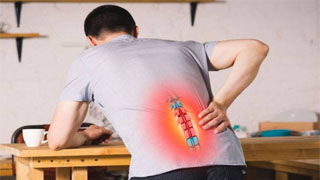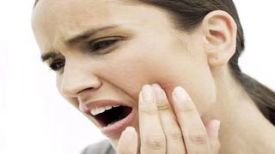
Due to excessive workload or intense study, more and more young people are suffering from lumbar muscle strain. This is no longer a disease exclusive to the elderly. Mainly due to a lack of exercise. So, how to treat lumbar muscle strain in young people? What causes lumbar muscle strain? Let's take a closer look below.
The general term for all lumbar muscle strain diseases characterized by soreness, swelling, and pain in the lower back due to prolonged exposure of the lumbar muscles (whether you are standing, sitting, or even sleeping) or repeated stretching and bending of the waist, including lumbar transverse process syndrome, lumbar back fascial pain syndrome, and lumbar sacral ligament injuries.
The pathogenesis of lumbar muscle strain: Muscles are like rubber bands. If they maintain the same posture for a long time or stretch beyond their capacity, it will inevitably lead to fatigue, injury, and pain. Pain can cause muscle spasms, squeezing the blood vessels that supply the muscles, resulting in thinning of blood vessels and muscle ischemia (even when exposed to cold, the temperature decreases and blood vessels contract, leading to muscle ischemia and injury), further exacerbating muscle damage.
lumbar muscle degeneration
Fasciitis of the lumbar and back muscles
Lumbar muscle strain, also known as lumbar back myofascial inflammation or chronic muscle strain, is an inflammatory strain disease caused by external pulling, injury, or twisting of the waist and back muscles and fascia. Lumbar muscle strain refers to acute and chronic aseptic inflammation of the muscles in the lower back, which can lead to common diseases such as lower back pain, lower back pain, lower back swelling, and lower back weakness. The specific symptoms are as follows:
1. Acute lumbar muscle strain: commonly seen after twisting the waist, such as shaking the waist when carrying heavy objects or sneezing, can cause severe pain in the waist and back, limited lumbar movement, and require bed rest for 1-2 weeks, even wearing waist circumference, to avoid the acute phase of lumbar muscle strain from extending to chronic lumbar muscle strain;
2. Chronic lumbar muscle strain: Most patients' lumbar muscle strain is chronic lumbar muscle strain, mainly caused by long-term improper posture, sitting for long periods of time, standing for long periods of time, bending over to carry heavy objects, or long-term fatigue in the waist, resulting in chronic aseptic inflammation of the lumbar fascia. Mainly causing soreness, bloating, and weakness in the lower back, and acute attacks can lead to lower back pain.
Because the lumbar muscles include: the anterior iliopsoas muscle, the greater lumbar muscle, the lesser lumbar muscle, the iliopsoas muscle and the greater lumbar muscle, as well as the posterior erector spinae muscle and quadratus lumborum muscle, among which the erector spinae muscle includes the iliopsoas muscle, the longest muscle, and the spiny muscle.
Muscles of the lumbar spine, iliopsoas, psoas minor, quadratus lumborum, erector spinae erector spinae
Generally, when people feel lower back pain, it is usually due to problems with the muscles mentioned above.
Reasons for lumbar muscle strain
The pain caused by lumbar strain is closely related to daily life, and some bad habits in life are the causes of lumbar muscle strain. If not taken seriously, it can lead to lumbar muscle strain. So, what are the factors that cause lumbar muscle strain in daily life?
1. Acute lumbar sprain and long-term recurrent lumbar muscle strain.
2. Delayed treatment and improper handling methods.
3. Long term repeated excessive lumbar exercise and overload, such as sitting for a long time, standing for a long time, or holding heavy objects from a bent position to an upright position, or collecting, organizing, and lifting objects on medical education websites, can keep the lumbar muscles in a high tension state for a long time, which can lead to chronic lumbar muscle strain over time.
4. Chronic lumbar muscle strain is also related to climate and environmental conditions. Low temperature or high humidity can promote or worsen lumbar muscle strain.
5. If two people do not move in the same order when lifting heavy objects, or if one person accidentally slips their hand, it can cause the other person's lumbar muscles to contract forcefully without preparation, resulting in sprains and acute lumbar muscle strain.
6. When carrying heavy objects with one hand, it can cause severe contraction of the contralateral sacral spine muscle, and sometimes it can also cause injury, such as carrying a bicycle or lifting heavy objects upstairs. Everyone must pay attention to this in their daily lives.
7. When pushing, lifting, pulling heavy objects, or lifting heavy objects with both hands in the previous period, these require a lot of strength from the lumbar muscles, which can easily cause lumbar muscle strain.
8. Poor posture, when sitting or standing incorrectly for a long time, can easily cause tensile damage to the soft tissues of the waist, leading to lumbar muscle strain over time. In addition, excessive force or sudden external impact, as well as tearing injuries at the sacral spine muscle insertion point when bending down to carry heavy objects, can also easily cause lumbar muscle strain.
9. Walking on slippery ground and accidentally slipping or falling down stairs can easily cause acute lumbar muscle strain.
Symptoms of lumbar muscle strain
Lumbar muscle strain is actually a chronic inflammatory injury of the fascia or periosteum of the lumbar muscles and their attachment points, which is a common cause of lower back pain. The symptoms of lumbar muscle strain include the following.
1. Lower back pain or swelling, with some stabbing or burning pain.
2. When tired, it worsens, but when resting, it decreases; Moderate activity and frequent changes in position can alleviate symptoms, while excessive activity can worsen.
3. Cannot persist in bending over to work. Often forced to constantly stretch or punch the waist to relieve pain.
4. There are tender points in the waist, mostly located at the sacral spine muscle, posterior iliac spine, sacral posterior sacral spine muscle insertion point, or lumbar transverse process.
5. The appearance and movement of the waist are mostly normal, and there is no obvious spasm of the lumbar muscles. A small number of patients have slightly restricted lumbar movement.
6. Complications: If patients repeatedly experience lumbar muscle strain or fasciitis, it can accelerate the degeneration of the lumbar spine. Over time, it may lead to more severe lumbar disc herniation or lumbar spinal stenosis.
The clinical manifestations of lumbar muscle strain include the following four:
1. Slow onset, with no obvious cause or chronic pain after fatigue as the main symptom.
2. There are fixed tender points in the pain area. Tapping at tender points can alleviate pain, which is one of the differences from deep bone diseases.
3. There are unilateral or bilateral spasms of the sacral spine muscles.
4. May have a history of kyphosis, lateral processes, or long-term sitting, bending, and weight-bearing.
5. Lower back pain, weakness in the waist, and accompanying movement disorders in the waist. At this point, it is easy to confuse it with lumbar disc herniation. The difference will not be explained in detail here. Please refer to: Science Popularization | Lumbar disc herniation vs. lumbar muscle strain. Can you distinguish it clearly?
In clinical examination, lumbar muscle strain mainly manifests as weakness and weakness of the lumbar muscles, without obvious tenderness or other symptoms.
6. Cannot sit for long periods of time, stand for long periods of time, or bend over. Hammer hitting the waist and back with both hands will give a sense of relief, while bending over for a long time will make it difficult to straighten the waist. Rainy and rainy weather will worsen, but it will be relieved after hot compress.
7. Long term recurrent back pain and discomfort, sometimes mild and sometimes severe, or presenting as dull swelling pain.
Adverse factors causing lumbar muscle strain
Lumbar muscle strain is not developed in a day, it goes through a long-term process.
There are four main reasons for lumbar muscle strain:
1. Long term excessive weight-bearing
When the human torso is carrying weight, the waist is the connecting part of the body and experiences significant pressure.
2. Instability of spinal structure
The spine determines the stability of the human body (trunk). When the structure of the spine is unstable, the muscles in the lower back will assist, and in the long run, it will overload the muscles in the lower back.
3. Long term bending over
Bending down for too long can cause sustained tension in the waist muscles, and long-term local stimulation can lead to aseptic inflammation.
4. Other
For example, if the waist is injured but not treated properly, it can gradually develop into lumbar muscle strain. Due to the fact that the main symptom of lumbar muscle strain is lower back pain, further examination is needed to determine the specific cause of lower back pain.
Treatment of lumbar muscle strain
Lumbar muscle strain is actually a chronic inflammatory injury of the fascia or periosteum of the lumbar muscles and their attachment points, which is a common cause of lower back pain. How to treat lumbar muscle strain? Firstly, the patient's blood circulation should be improved. Patients can use massage, traction, local heat transfer, iontophoresis, ultra short wave, audio and other methods to relieve muscle spasms and improve blood circulation. In addition, patients can also be treated with acupuncture and moxibustion and traditional Chinese medicine. Acupuncture and cupping have certain effects, which can relieve pain. Traditional Chinese medicine focuses on eliminating evil and strengthening the body.
Other treatment methods for lumbar muscle strain:
1. Self care therapy: Take appropriate rest, avoid overwork, and correct improper posture. Regularly changing posture and avoiding bending over and holding objects are fundamental methods to alleviate symptoms and prevent recurrence. At the same time, the strength of the waist muscles should be trained to increase the compensatory adjustment ability of undamaged muscles.
2. Appropriate functional exercises, such as waist and back muscle exercises, can prevent muscle tone imbalance.
3. Drug therapy: mainly includes anti-inflammatory and analgesic drugs, as well as traditional Chinese medicine for relaxing tendons and promoting blood circulation; Adrenal corticosteroid injection treatment for tender points; When pain significantly affects work and rest, nonsteroidal anti-inflammatory drugs, topical muscle relaxants, or sedatives can be taken.
4. Blockade therapy: For those with fixed tender points, 5-10ml of 0.5% to 1% procaine combined with 0.5-1ml of prednisolone acetate or hydrocortisone acetate can be used for pain point blockade, with good results.
5. Surgical treatment can be performed for cases where various non-surgical treatments are ineffective.
6. Healing criteria: disappearance of symptoms and restoration of function.
7. Improvement criteria: Reduced back pain and restricted spinal movement.
Anatomy based lumbar muscle strain, looking at lower back pain from the root. In fact, replacing 'lumbar muscles' with' lumbar muscles' would be more accurate.
How to prevent lumbar muscle strain
1. The waist muscles need to be exercised
Walking backwards, practicing yoga, jogging, etc. can all exercise the waist muscles. At the same time, you can also frequently twist your waist and do swallow flying exercises in bed before going to bed. For office workers who sit for a long time, they can do chest expansion exercises at regular intervals every day (with their elbows flat), as well as leaning back and pulling upwards.
2. Keep warm all year round
Menstrual period, childbirth, etc. can all damage kidney qi, so women should always pay attention to keeping their waist warm. During the confinement period, it is necessary to wear long clothes to protect the waist and prevent back pain caused by postpartum diseases.
3. Kidney yin and kidney deficiency need to be regulated and supplemented
If there is excessive menstrual flow, frequent cold and painful waist, and cold sexual desire, the kidneys should be taken care of in a timely manner. Women should supplement kidney yin more to enhance their resistance. You can eat more kidney tonifying foods, such as goji berries, yam, longan, and walnuts. You can also often take some traditional Chinese patent medicines and simple preparations, such as Liuwei Dihuang pills. For those with yin deficiency and excessive fire, they can take Zhibai Dihuang Wan, and for those with kidney yang deficiency and lower back pain, they can take Jinkui Shenqi Wan.
4. The thickness of the mattress should be moderate
The waist has a physiological curvature, and the mattress can be appropriately thickened with moderate hardness to allow the lumbar muscles to rest fully.
5. The heel height should be suitable
Do not wear shoes that are too high, as they can increase fatigue on the waist. People who stand or walk for a long time should try to wear them as little as possible. At the same time, try not to wear low waisted pants during menstruation and lactation. High heels can shape a woman's graceful figure, but they are also one of the "killers" of women's health. Remind you to take off your high heels as much as possible during leisure time to relax your feet and relieve the fatigue on your waist.
6. Moderate sexual activity and contraception
Many cases of induced abortion can easily damage the kidneys and cause inflammation. Sexual activity should be avoided and contraception should be taken seriously.
Rehabilitation training for lumbar muscle strain
1. Pelvic oblique lift movement
Lying in a supine position, bending both knees, then firmly clamping the hips, contracting the abdomen, pressing the lower back tightly against the floor, and then raising the hips can strengthen the gluteal and abdominal muscles, reducing lumbar flexion.
2. Unilateral knee hugging exercise
Lie in a supine position, bend both knees, then firmly clamp the hips, contract the abdomen, and then hold one knee close to the chest with both hands, then return to its original position, repeat 5 times, and switch to the other knee. This exercise can pull the muscles in the lower back, knee, and back, as well as the muscles in the opposite hip.
3. Bilateral knee hugging exercise
Lie flat and bend your knees, hold your knees and touch your chest, slowly tighten until you feel your back being stretched. Repeat 5 times. This exercise can pull the muscles behind the lower back and knee, strengthen the abdominal and hip flexors.
4. Unilateral straight leg lifting exercise
Lying in a supine position, with one knee bent and the other side straight and flat, clamping both buttocks, contracting the abdomen, raising the lower limb on the straight side, then slowly lowering it, repeat 5 times. Switch to the other limb. It can pull the muscles behind the lower back and knee, strengthen the abdominal muscles and hip flexors.
5. Waist Stretching Exercise
Prone position, extend your hands behind your hips, with your abdomen as the support point. Release your chest and lower limbs from the bed at the same time and then relax. Repeat 5 times to enhance lumbar muscle strength.


